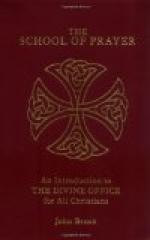Rithmis et sensu verborum
consociatum
Psalterium Jesu, sic
est opus hoc vocitatum,
Qui legit intente, quocunque
dolore prematur,
Sentiet inde bonum,
dolor ejus et alleviatur;
Ergo pius legat hoc
ejus sub amore libenter,
Cujus ibi Nomen scriptum
videt esse frequenter.
Versicle and respond are placed after the psalms and before the lessons to rouse the attention which is necessary before all prayer, and the lessons are a noble form of prayer. These little prayers are of very ancient origin and were dealt with by Alcuin (735-804) in his recension of the Gregorian books for use in Gaul. His pupil, Amalare, also studied them, so that a meaning should be found in what was sung, and that the truncated repetitions should be avoided. He retained what was traditional and ancient, introduced versicles and responds taken from ancient Roman books and from books belonging to Metz, selected passages from the Gospels which seem to fit in with the antiphons and added them to what he found in the Roman books, made alterations in the order here and there and gave completion to the whole by adding some offices for saints’ days proper to the Church of Metz (Baudot, The Roman Breviary, p. 88). Amalare had been administrator of the diocese of Lyons during the exile of Agobard the Archbishop. The latter, with learning and bitterness, attacked the reforms of Amalare, but, “in spite of all, the reform of Amalare held its ground in Metz, and then in the greater number of the churches north of the Alps” (Baudot, op. cit.). Much of the work of Amalare stands in our Breviary.
Pater Noster is said to beg from God, light and grace to understand the doctrine contained in the lessons. In choir, a part of the Pater Noster is said in common and in a loud voice to recall the Communion of saints.
Absolutions and Blessings. “The custom of giving a blessing before the lections was already in existence in the fourth century. The ruler of the choir, who gave it in the beginning, gave also the signal for the termination of the lesson by the words, ‘Tu autem’ (scil, desine or cessa), to which the reader responded ‘Domine miserere nobis,’ while the choir answered Deo gratias. In the palace of Aix-la-Chapeile, it was by knocking, and not by the words Tu autem, that the Emperor Charlemagne gave the signal for the conclusion of the lections, while the lector recited himself, Tu autem, Domine miserere nobis. The Rituale Ecclesiae Dunelmensis, containing fragments of the Roman liturgy from the end of the seventh to the ninth and tenth centuries, includes forms of blessing for the different festivals, sometimes three, sometimes nine. In the latter case each lesson was provided with its own form of blessing, which correspond with the mystery commemorated by the festival. The absolutions, Exaudi Domine and A vinculis peccatorum did not appear until the succeeding period” (Baudot, op. cit., p. 74).




